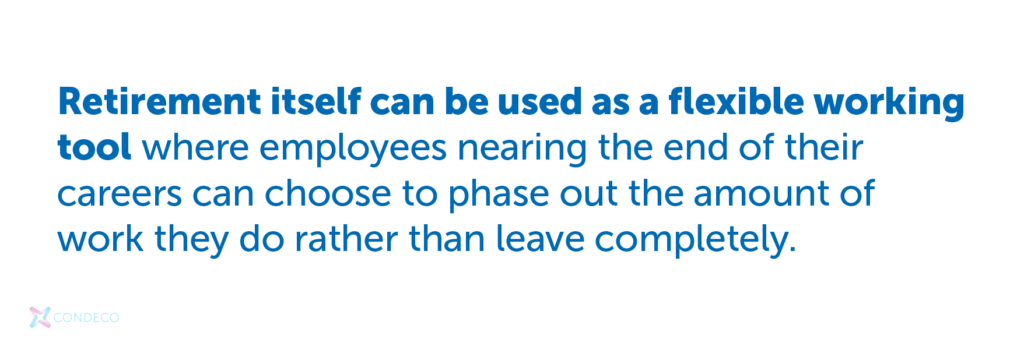
Introducing a flexible work scheme usually involves a discussion about location. Three of the most popular types — hybrid, remote, and working from anywhere — relate to where people work on any given day, whether at home, the office, or elsewhere. It’s about how those work patterns fit together into one cohesive whole.
As part of this mix employers often consider the working hours of their employees and the possibilities of flexible working. Flexible working can mean different things to different businesses, and there’s a wide range of possibilities. The beauty of flexible working is its adaptability. Whether it’s offering employees the right to choose their hours or share their roles, the type of flexible working that’s right for your business will depend on what you’re trying to achieve. You need to consider how you can best get control over your arrangement to encourage collaboration, maximize office capacity and give everyone who works for you greater certainty.
Let’s dive into the main forms of flexible working and how they could fit into your flexible work arrangement. We consider how flexible working can offer the capacity to adapt your office and provide a more attractive and productive working space.
1. Part-time work

One of the most basic examples of flexible working is part-time work. An employee commits to certain hours per week or month, usually on specific days. It saves money if a role does not require five days a week or allows a valued employee to use their days or hours off as they wish.
The downside is when that employee is unavailable to work at a crucial moment on a project or fails to hand over crucial information before leaving for a long weekend. However, this is a good option for smaller companies that may not be able to afford senior people in full-time positions or have certain days when work is more intense.
2. Job sharing
Job sharing is an increasingly popular option for employers. The arrangement can be varied and could involve one person doing a role in the morning and another doing the same in the afternoon. One employee may work two days a week and three days for another. They could even work on the same three days a week.
One of the big advantages of job sharing is having two experienced people doing the same job, which means more input in terms of ability and ideas, as well as a level of coverage for times such as holidays or if one of the employees decides to leave. On the downside, the communication between the two employees needs to be good so work can be handed over simply and seamlessly. And what if the two people sharing the job don’t get on? Those tensions can seriously affect overall performance.
3. Job splitting

Job splitting is similar to job sharing, except that the role itself is segmented, so employees carry out different tasks. While it loses some of the impact of a total job share, it can be more convenient and mean fewer senior personnel are needed for one role.
Either way, job sharing, or job splitting could be the answer for employees needing time to do something in their personal lives. It can also be a great tool for keeping the best people. However, it does need careful consideration to ensure the business gets the best from the arrangement.
4. Compressed working
Many people are increasingly questioning the five-day week. Is it an anachronism of the 20th century or a necessity for modern business to function? The question is open to debate, but a four-day week policy could fit well with your flexible work scheme.
Three-day weekends are an attractive proposition, and compressed working is designed to deliver longer breaks by asking an employee to do four days of work in five. This may involve reducing income or working longer hours during the four days.
For the most progressive employer, it may mean neither of these, but few are ready to take this step despite recent studies showing that a four-day week can improve productivity. It’s an option well worth considering if you’re looking for happier workers, more space in your office, and a means of attracting talent through policies that cater to different lifestyles. You’ll need to consider who covers for your employee on those extra days, and, for example, in customer-facing roles, it may not be suitable.
5. Staggered hours/shift work

One way of offering flexible working hours that fit in with the employee’s lifestyle is staggered hours. This means they can choose different start, finish, and break times from fellow workers. It doesn’t necessarily have to mean working night shifts; it could involve starting and ending the working day 2 or 3 hours earlier or later than is typical.
This can give you greater control over your workplace, meaning not everyone is in the office at the same time. It’s important to find the right balance so that the job requirements are fully met. It’s also important that communications with other workers can still occur and that any handover is smooth and seamless.
Without being too controlling, these staggered hours should be formalized in the employment contract. This would ensure employers know who is working exactly, allowing them to manage workloads and priorities accordingly.
6. Annualized hours
As the name suggests, annualized hours are a form of flexible working in which an employee agrees to work a set number of hours every year. A business’s advantage is the ability to flex those hours to meet temporary uplifts in demand and, likewise, any fallow periods. This can save on traditional overtime costs and ensure that the business is at the capacity it needs when it needs it.
For the employee, it can mean the ability to take time off at certain periods and choose the hours that suit them best. These hours can be broken down into ‘core,’ the basic amount expected to be worked yearly, or ‘unordered,’ where the employee agrees to work hours if required.
Obviously, your employer contracts will have to be carefully written, but this is a great choice for seasonal businesses or those who are confident when supply and demand are at their highest.
7. Reduced retirement

The days of retiring in your mid-60s with a gold clock are fading fast. Now, retirement itself can be used as a flexible working tool where employees nearing the end of their careers can choose to phase out the amount of work they do rather than leave altogether. As they may also receive benefits from their part-time retirement, they are financially able to work fewer hours and can be asked to work when necessary, rather than a full five-day week.
This can be an excellent option for employers who want experienced employees to remain as long as possible and for employees not yet ready to fully embrace their golden years and enjoy some of the benefits of retirement without the subsequent drop in income.
Free to choose
It may be that flexible working doesn’t work for your business at all. In that case, introducing a flexible work scheme will involve discussing issues such as remote working and how best to manage visits to the office. However, for those looking to deliver the best and most efficient operations, it is something that needs to be seriously considered in the mix.



